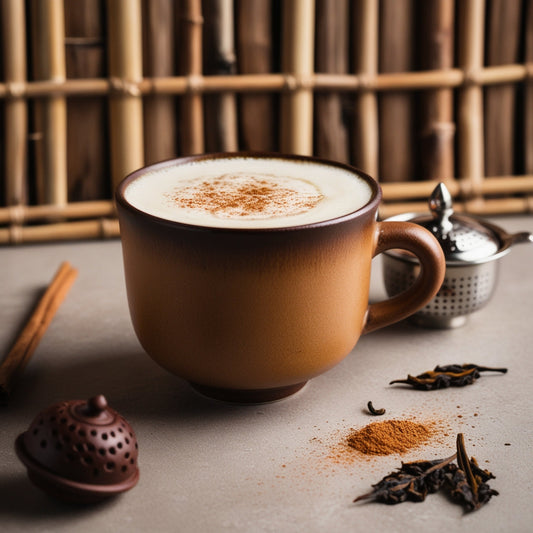Introduction
Imagine sipping a tea that not only delights your taste buds with a symphony of earthy and floral notes but also transforms with each brew, offering a new sensory experience every time and Health Benefits . Welcome to the world of Pu-erh tea. This unique beverage, cherished for centuries in China, offers a rich tapestry of flavours and aromas, classified into two main types: Raw (sheng) and Cooked/Ripe (shou). Whether you are a seasoned tea connoisseur or a curious newcomer, understanding the flavours of Pu-erh tea, the ideal brewing methods, and proper storage techniques will elevate your tea-drinking experience to new heights. Let's embark on a flavourful journey to uncover the secrets of Pu-erh tea.
Table of content
- Introduction
- How Pu-erh tea tastes?
- How much pu-erh tea should I drink?
- How much Pu-erh tea to use?
- How much Pu-erh tea per cup?
- How long does Pu-erh tea last?
- Conclusion
How Pu-erh Tea tastes?
Pu-erh tea can be classified in two different ways: Raw (sheng) and Cooked/Ripe (shou). This classification depends on the amount of processing the tea leaves undergo after being picked and withered.
Raw Pu-erh Tea
Raw Pu-erh tea made from old-growth arbour trees offers a variety of aromas and flavours. The different taste profiles in Pu-erh depend on the grade of the leaves, the stages of aging, and the types of trees grown in the surrounding area. As the old-growth arbor tea trees have very deep roots, they intertwine with the roots of nearby forest trees over time and absorb the fragrances emitted from them.
Sometimes, the taste profile transforms from one flavour to another between brews of the same tea, or one may experience a bouquet of flavours within a single brew. Many Pu-erh enthusiasts agree that the best taste is obtained around the 4th or 5th brew, when the leaves are fully unfurled and the flavours are released.
Ripe Pu-erh Tea
Ripe Pu-erh, having undergone full fermentation, loses much of the bitterness and astringency inherent in the tea leaves. Generally, ripe Pu-erh tastes earthy, nutty, or woody. High-quality aged Pu-erh tea should be mellow, smooth, and offer a sweet aftertaste (hui tian) of sugarcane or plum. Poor quality ripe Pu-erh, on the other hand, is flat, dull, thin.

How Much Pu-erh Tea Should I Drink?
It is advisable to limit Pu-erh tea consumption to no more than 400 ml per day. Exceeding this amount significantly may cause "tea intoxication," characterized by light dizziness and euphoria. During pregnancy, you can drink Pu-erh tea, but avoid it in the first trimester due to its tonic effect, which can affect the uterus. In the second and third trimesters, limit consumption to no more than 100 ml per day, and only if you have no medical contraindications.
Caffeine Content
Pu-erh tea has moderate caffeine content, which varies depending on whether it is raw or cooked. This variability allows for different levels of stimulation based on personal preference.
How Much Pu-erh Tea to Use?
Place approximately 1 teaspoon of organic Pu-erh tea into the cup. Pour the heated water into the cup, steep to your desired strength, and enjoy. Straining is not required, as the tea will generally sink to the bottom of the cup. If you want to drink more tea, simply refill the cup with more hot water and repeat the process.

How Much Pu-erh Tea per Cup?
Measure three grams of tea for every 6 oz of water. Pour water at 208-212 degrees Fahrenheit over the leaves and steep for 10-20 seconds, then pour off the water. This process, called rinsing the leaves, removes impurities and allows the leaves to begin opening. Next, pour another 6 oz of water at 208-212 degrees Fahrenheit, steep for about 30 seconds, and serve. You can re-steep the same leaves 4-8 times in a similar fashion, adding 15-30 seconds to each steeping time.
How Long Does Pu-erh Tea Last?
Proper storage conditions significantly impact the flavour of Pu-erh tea. Follow these tips for optimal storage
Humidity
Maintain relative humidity levels at approximately 60-70% to ensure proper aging without risking mould growth.
Temperature
Keep Pu-erh tea at a consistent temperature, away from direct sunlight and heat sources, to preserve its innate flavours.
Airflow
Ensure good air circulation while preventing exposure to strong odours, which the tea leaves could absorb.
Conclusion
Pu-erh tea offers a remarkable journey of flavours, from the complex, evolving profile of Raw Pu-erh Tea to the rich, mellow notes of Ripe Pu-erh Tea. Whether you are looking to explore the distinctive aromas and tastes or seeking the best brewing methods, understanding these aspects will greatly enhance your tea-drinking experience. Remember to enjoy Pu-erh tea in moderation, particularly during pregnancy, and follow proper storage techniques to maintain its exquisite flavours.
Embark on your Pu-erh tea adventure. Discover the most Premium selection of Pu-erh teas with Puer Craft and elevate your tea experience. Immerse yourself in the rich traditions and unique flavours of Pu-erh tea.
Q & A
Q. What are the two main types of Pu-erh tea and how do their taste profiles differ?
A.The two main types of Pu-erh tea are Raw (sheng) and Cooked/Ripe (shou). Raw Pu-erh, made from old-growth arbor trees, offers a variety of aromas and flavors that can transform with each brew. It typically becomes best around the 4th or 5th brew. Ripe Pu-erh, which undergoes full fermentation, generally tastes earthy, nutty, or woody, with high-quality varieties offering a smooth, sweet aftertaste.
Q. How much Pu-erh tea is recommended for daily consumption and what are the considerations for pregnant women?
A.It is advisable to limit Pu-erh tea consumption to no more than 400 ml per day to avoid "tea intoxication," which can cause light dizziness and euphoria. Pregnant women should avoid Pu-erh tea in the first trimester due to its tonic effect on the uterus. In the second and third trimesters, they can consume up to 100 ml per day, provided there are no medical contraindications.
Q.What is the proper method for brewing Pu-erh tea, including the amount of tea and water temperature?
A. Use approximately 1 teaspoon of Pu-erh tea per cup. Pour water heated to 208-212 degrees Fahrenheit over the leaves and steep to your desired strength. For each 6 oz of water, use three grams of tea. Initially steep for 10-20 seconds to rinse the leaves, then for subsequent steeps, use 30 seconds, increasing by 15-30 seconds with each re-steep. You can re-steep the same leaves 4-8 times.
Q. What are the optimal storage conditions for Pu-erh tea to maintain its flavor?
A.Pu-erh tea should be stored with relative humidity levels at approximately 60-70% and kept at a consistent temperature, away from direct sunlight and heat sources. Good air circulation is necessary, but the tea should be protected from strong odors that it could absorb.
Q.Why is it important to rinse Pu-erh tea leaves before brewing, and how is this done?
A. Rinsing Pu-erh tea leaves is important to remove impurities and allow the leaves to begin opening. This is done by pouring water at 208-212 degrees Fahrenheit over the leaves, steeping for 10-20 seconds, and then pouring off the water. After rinsing, proceed with the main brewing process.






